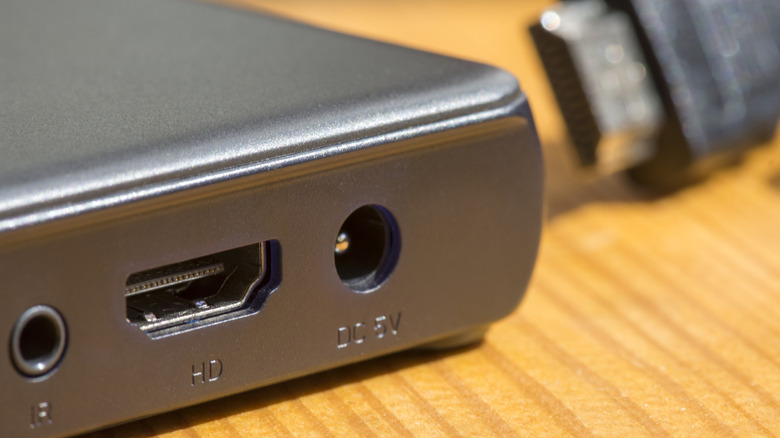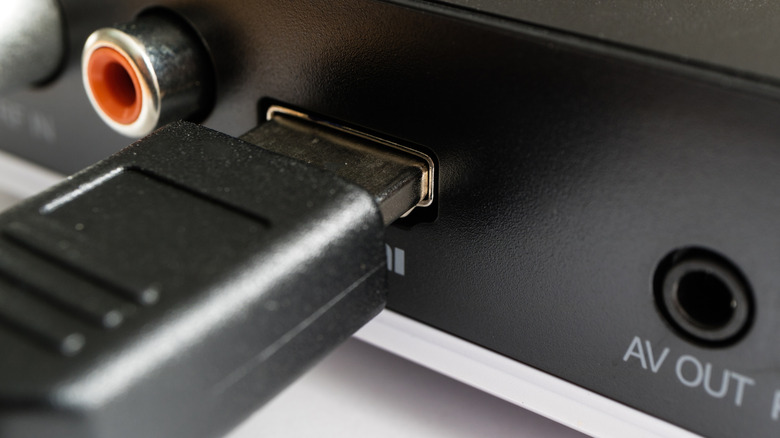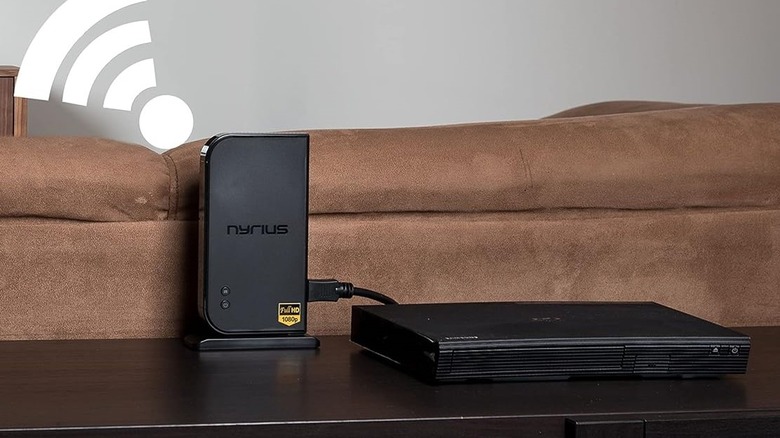Is Wireless HDMI A Real Option For Home Theaters?
We may receive a commission on purchases made from links.
There's nothing quite like dealing with a mess or tangle of wires, whether it's power cords for chargers and power adapters, media cables for connecting your home theater devices, or audio cables for syncing speakers and other surround tech. Sometimes, it would be nice if everything connected wirelessly. Invisible tendrils, no physical cables or strands, a lot less mess and a much better-looking setup. Unfortunately, that's not always possible. But in some cases, it totally is through a quick upgrade. Exhibit A: wireless HDMI transmitters.
A wireless HDMI transmitter, also sometimes called a wireless HDMI extender, is a small, two-part system that consists of a transmitter and a receiver. Together, they send audio and video signals from one source to another, almost exactly like a standard HDMI cable would. You can connect, say, a Blu-Ray player to your TV using a wireless connection. That can work out great, for example, if you mount your TV while you have your media devices placed below on an entertainment center. It's also a useful way to connect projectors to media devices, set-top boxes and consoles, which are usually placed some distance away. It would definitely help if you're trying to connect one of the best portable projectors to your streaming devices. But how does this affect visual fidelity? Is wireless HDMI a real option for home theaters and serious cinephiles? Exploring the technology's limitations is a good way to find out.
Wired versus wireless HDMI
As a quick primer, High-Definition Multimedia Interface (HDMI) is a proprietary digital interface used to transmit video and audio signals between compatible devices, and ultimately exists to facilitate high-quality transmission. It's an upgrade over older analog interfaces like S-Video or VGA. HDMI can carry both audio and video signals in a single cable when wired. That makes it very convenient for connecting media devices to displays and TVs, like a game console, Blu-Ray player, or multimedia player. There are other formats of HDMI, too, like the HDMI ARC port on a smart TV. But when it comes to sleek or minimal aesthetics, no physical cable is really a preferred answer. No one wants to see a bunch of wires hanging down walls, tucked behind furniture or ingeniously hidden with fixtures and other eye tricks.
Wireless HDMI takes that standard and eliminates the physical cable(s). By some, it's considered more aesthetically pleasing because a wireless connection is invisible. It can also theoretically stretch a little further than a cable, as long as the receiver and transmitter are within range. You don't have to spend extra on a 50-foot cable to separate the devices by that distance, for example. Moreover, because HDMI is a standard, wireless HDMI tech should work with pretty much any HDMI-ready device. The best wireless HDMI transmitters you can buy on Amazon should work with just about anything.
What are the trade-offs of wireless HDMI?
Because wireless HDMI requires multiple devices, including a transmitter and receiver, the upfront cost is usually higher than simply buying a cable. One top wireless AV device, the Nyrius Aries Home+, costs about $250 at full price. A viable alternative, the J-Tech Digital WEX200V3 1X2 wireless 1080P HDMI extender, although cheaper, is still around $170. By comparison, a 20-foot HDMI cable is about $20 to $30, with the best HDMI 2.1 cables in that same range, so significantly cheaper. Another concern is the potential for electromagnetic interference (EMI) from nearby or surrounding devices. Other network devices — like a router transmitting Wi-Fi — could cause signal interference. The same can happen with other electronics, especially if they use Bluetooth, or metallic objects and surfaces known to block wireless electrical signals. Keep the transmitter and receiver away from other electronics and interfering objects.
Most wireless HDMI systems operate the same. You connect the transmitter to the device you want to broadcast, like your console or DVD player. Then, you connect the receiver to the TV. Today's wireless HDMI systems can be up to 200 feet away from each other. It would be a little strange to have your devices that far away, but still, it's good to know. They should communicate automatically, which means it should work right out of the box. While you might expect wireless HDMI to sacrifice visual fidelity, that's not usually the case. Wireless HDMI devices can transmit up to 4K with clear signals and sharp visuals. There doesn't appear to be any 8K options on the market yet. What could hinder quality is the EMI interference, not the wireless HDMI tech directly.


